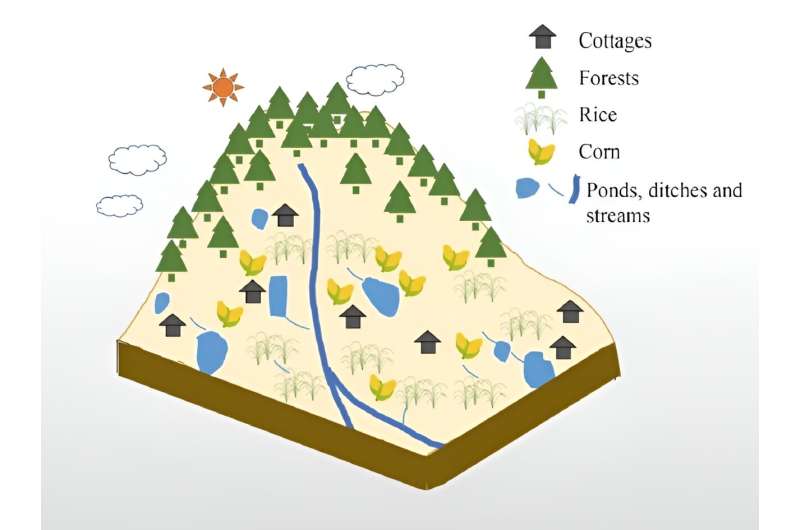This article has been reviewed according to Science X's editorial process and policies. Editors have highlighted the following attributes while ensuring the content's credibility:
fact-checked
proofread
Jinglinxi, China: Ditches and ponds could be used in upland catchments to balance drainage and intercept pollutants

Globally, non-point source pollution is an important source of water quality deterioration in rivers and lakes. A ditch-pond system, consisting of ditches and ponds, is considered to be similar to free-surface wetlands, linking pollution sources to the receiving water bodies.
The ditch-pond system includes vegetation, microorganisms and sediment, which can slow down the flow velocity and promote the precipitation of particulate matter carried by running water. At the same time, ditch and pond systems reduces nitrogen and phosphorus concentrations, and those of other nutrients entering the downstream water by means of plant absorption, sediment adsorption and microbial degradation, so as to reduce agricultural non-point source pollution.
As an important farming area in southern China, the Three Gorges Reservoir area covers a wide area of hills and serious soil erosion, which further exacerbates the problem of agricultural non-point source pollution.
In China, ponds are mainly distributed in the eastern and southern regions. However, most of the studies on ditches and ponds have been conducted in the lowland areas, and there are few studies with field observations in upland areas. What kind of function the ditch-pond system plays in the water environment in the mountain catchment is worth studying deeply.
Large water bodies, especially lakes and wetlands, have been given more attention as important geographical features of global terrestrial systems. Compared with large water bodies, small water bodies such as ponds are common, but receive limited attention and are often ignored.
Prof. Lei Chen and his team used high-resolution remote sensing data to analyze changes in ditches and ponds within the catchment. The work is published in the journal Frontiers of Agricultural Science and Engineering.
The results showed that over the past 15 years the length of ditches in the catchment and the number of small ponds (less than 500 m2) have increased by 32% and 75%, respectively. The concentration of pollutants in the ditch and pond system was much higher than that in the mainstream in the catchment, indicating that dense ditch-pond network not only increases the confluence time, but also is more conducive to the interception of pollutants.
By comparing the pollutant concentrations at the inlet and outlet of different ditches and ponds, it was found that the change rate of nutrient concentration in ditch-pond is mostly between –20% and 20%, indicating ditches and ponds can be both sources and sinks for agricultural pollutants.
Although ditches and ponds are sometimes a source of pollutants, they help regulate the hydrology and water quality of catchment. In addition, this study also compared the effects of different texture ditches on pollutant interception.
It was found that the interception effect of concrete ditch on particulate phosphorus is better than that of soil ditch in dry season.
Based on the research results, the researchers think that retaining the sediment in the ditch in dry season and cleaning the sediment in time in rainy season can help the ditch-pond system to transform from source to sink effectively.
Therefore, the function of balancing the drainage and interception functions of the ditch-pond system can maximize its ecological role in the catchment.
More information: Yiwen WANG et al, Ditches and ponds can be the sources or sinks of non-point source pollution: observations in an upland area in the Jinglinxi catchment, China, Frontiers of Agricultural Science and Engineering (2023). DOI: 10.15302/J-FASE-2023517
Provided by Higher Education Press





















